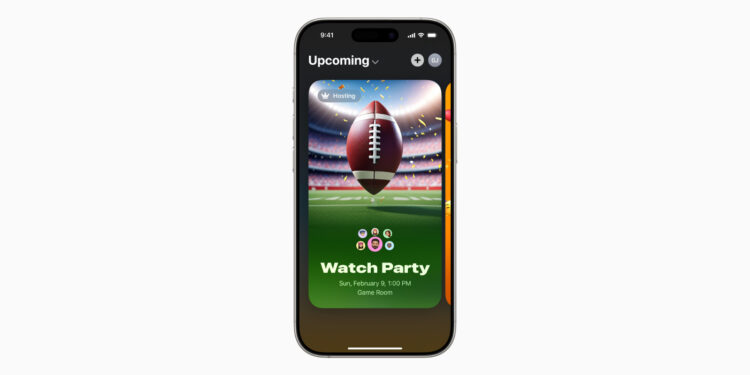Apple has released a new app called Apple Invitations that is designed to make organizing and managing events easier. The idea sounds promising: you can create events, invite guests, and manage their attendance directly in the app. But the implementation is not quite as intuitive as you might expect. Here you can find out how to use Apple Invitations, what advantages it offers, and what pitfalls there are.
If you have ever organized a party or an event, you know that it takes a lot of effort to get all the guests together. Sending invitations, managing acceptances and rejections, creating a shared photo album or playlist - all of this can quickly become confusing. Apple is trying to simplify this process with Apple Invitations. The app links various Apple services together. This ensures seamless integration, but also brings with it some challenges. The registration process for guests in particular could be clearer and some steps feel unnecessarily complicated. Nevertheless, the app offers an interesting possibilityto organize invitations digitally.
What is Apple Invitations and how does the app work?
Apple Invitations is a free app for the iPhone, which you can use to create events, invite guests and manage their participation. There is one restriction, however: As an organizer, you need a paid iCloud+ subscription. Your guests, on the other hand, do not need an Apple account; they can also register via email or a link. When you send an invitation, your guests will receive a message or email with an iCloud link. There is already a first hurdle here:
- iPhone users are redirected to an iCloud login page when they click on the link, even though signing in is actually optional
- Android users can sign up but it is unclear what features they can use
Apple defaults to the iCloud login page and displays an app recommendation at the top of the screen. This can be confusing because it's not immediately obvious that you can just scroll down and log in with an email address.
How to create an event with Apple Invitations
Creating an event is basically simple, even if some steps seem unnecessarily complicated. Here's how it works:
- Open Apple Invitations
- Tap "Create Event"
- Choose a background or your own image (optional)
- Enter a title for the event
- Set the date, start and end time and location
- Add a description (max. 1,000 characters)
- Optionally create a shared photo album for the event
- Optionally create a shared Apple Music playlist
- Preview the invitation and tap Next
- Invite the guests and decide whether you want to admit them directly or confirm their participation manually
The integration of Apple Maps for selecting the venue is particularly useful. The ability to create a shared photo album is also a nice addition. However, the option to share an Apple Music playlist adds an extra step. You need an Apple Music profile to share playlists. If you only have an Apple Music subscription, that's not enough.
You can set up an Apple Music profile as follows:
- Open Apple Music
- Tap your profile icon (top right)
- Select "Set up profile"
- Enter a username
- Setting whether other users can follow your playlists
- Decide which playlists you want to share
This all sounds complicated at first and in tests it even happened that Apple Music froze at this point. So if you want to create a playlist for your event, you should be prepared for it not to always work smoothly.
Send invitations and manage participants
Once your event is created, you can invite your guests. You have two options:
- Generate a general invitation link
- Select specific contacts from your list
There is a limitation here, however: If you choose the option to select specific contacts, you must have previously specified which contacts can be shared. There are only two options: either you share all contacts or you choose a restricted list. There is no option to share only email addresses without any further contact details. After you send the invitation, your guests will receive a message or an email with an iCloud link. Be sure to include a short explanation so that the recipients know what it is about. When the guests receive the invitation, they can tap "Accept," "Decline," or "Maybe." As the organizer, you can see the responses in the app and can check the status at any time.
What happens after the invitation is sent?
As soon as your guests have responded, you will receive a notification. This is where the big advantage of Apple invitations becomes apparent: the app manages all responses automatically. If your guests use Apple invitations, they can also contribute photos and music. The app is therefore more than just an invitation tool - it also allows you to plan the event together. A major drawback, however, is that the event is not automatically saved in the Apple calendar. You have to tap the calendar symbol in the invitation yourself to create an appointment. This seems illogical, as Apple otherwise connects many services with each other.
Are Apple Invitations Worth It?
Apple Invitations is an interesting solution for organizing events, but it has some weaknesses. Especially for Apple users, the app offers a convenient way to plan events and manage guests. The integration of Apple Maps, Apple Music and Photos ensures a well thought-out approach. However, there is still room for improvement:
- Registration for iPhone users could be made clearer
- The sharing options for contacts are too limited
- Automatic calendar integration is missing
For smaller events and parties, Apple Invitations is a handy tool. However, if you are organizing an event with a lot of participants or have guests with Android devices, be prepared for things not to run smoothly. Looking for the best accessories? Visit our Amazon Storefront and discover a variety of products from top providers, including for HomeKit! (Image: Apple)
- Advanced visual search: Search iPhone photos smarter
- Apple explains: How to update the firmware of your AirPods
- Setting default apps on the iPhone – here's how
- Apple Maps Library: Easily save favorite places





